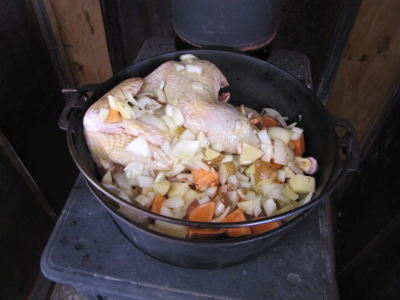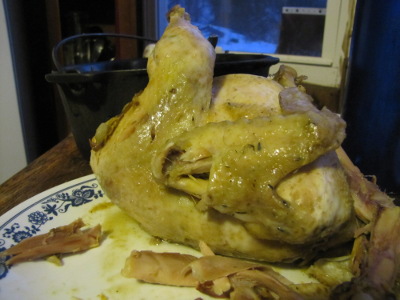
Dutch oven roasted chicken
 After
trying out the kindergarten level of cooking
on the wood stove, I
decided to move on to first grade. Joey gave us this beautiful
Dutch oven after our power outage last year, and it seemed to be the
obvious choice for expanding our culinary arts to roasting a
chicken. I prepared the veggies and chicken as I usually do when roasting in the
electric oven,
settled the fire on a medium-low setting, and then put on the lid of
the Dutch oven.
After
trying out the kindergarten level of cooking
on the wood stove, I
decided to move on to first grade. Joey gave us this beautiful
Dutch oven after our power outage last year, and it seemed to be the
obvious choice for expanding our culinary arts to roasting a
chicken. I prepared the veggies and chicken as I usually do when roasting in the
electric oven,
settled the fire on a medium-low setting, and then put on the lid of
the Dutch oven.
I stirred the vegetables
a few times so that they wouldn't stick to the bottom --- which I
assume is more of a problem in a Dutch oven since the heat comes up
from the bottom --- but I didn't have to baste the chicken at
all. That made this roast chicken a bit lower work than my
oven-roasted chicken, where I try to remember to baste every ten
minutes or so.  On
the other hand, the chicken took about half an hour longer than usual
to cook, and I was glad I had a meat thermometer so that I'd know when
the meat was safely done.
On
the other hand, the chicken took about half an hour longer than usual
to cook, and I was glad I had a meat thermometer so that I'd know when
the meat was safely done.
Our taste test declared
the Dutch oven roasted chicken and vegetables just as good as the
oven-roasted version, but the aesthetics weren't quite as good. I
didn't get the crispy skin I usually end up with and the vegetables
turned into a mush, making me think that I probably should have cooked
the chicken alone for about an hour before adding the root and onion
mixture.
In fact, the Dutch oven
roasted chicken reminded me of the results I've seen from folks who
roast their chicken in a crock pot. That makes me think that
crock pot recipes would be a good place to start when looking for meals
I can cook in the Dutch oven on top of the wood stove.
Want more in-depth information? Browse through our books.
Or explore more posts by date or by subject.
About us: Anna Hess and Mark Hamilton spent over a decade living self-sufficiently in the mountains of Virginia before moving north to start over from scratch in the foothills of Ohio. They've experimented with permaculture, no-till gardening, trailersteading, home-based microbusinesses and much more, writing about their adventures in both blogs and books.
Want to be notified when new comments are posted on this page? Click on the RSS button after you add a comment to subscribe to the comment feed, or simply check the box beside "email replies to me" while writing your comment.

This was a particularly interesting insight into the always learning and analysing brain of Anna (in all earnestness -- I love it)
Clear thinking leads to good and useful conclusion -- Dutch oven on stove cooks like a crock pot, thus - look for recipes for crock pots.
I have some education-related training and job experience so it delights me to see you doing something I've always had faith in -- seeing problem, thinking through problem, devising a test, condusting test, making observations, drawing conclusions and adjusting future methods accordingly. It seems like a style of education very suited to your lifestyle, and since I think alot of what you're doing is going to become very relevent to many more people very soon, I think project-based learning is yet another area where Walden Effect is leading the way
Hello Anna,
Here is a solution to that problem, Dutch ovens were made for HOT Environments all around the the body, that is why they are mostly made of Cast Iron. the solution to your issue is to raise the meat, so liquids will drain and evaporate, creating that dry enviroment to brown the chicken all around. Using a steel rack, a cake cooling rack, or some means to allow the liquids to not come in contact with the meat will allow it to smoke the meat in it's owne juices, creating an intense browning, you will need to watch to ensure you marinate in timely fashions,if needed. This can also be done slowly also. You can place your vegetables in at the beggining, on the rack moving them as needed to fully cook or partically to add finish at the end, if you choose to finish then at tne take then out when Firm to Taste!!!!!!
Check your meat to ensure it is not cooking to fast, If so, then remove form heat and allow to steam for about 15 minutes, check your meat temp, if it is close to being finished, removel all liquids cover tight and continue to brown until done!!!!
I hope this reads right, next time I will do a Cut and Paste!!!
Darryl
J --- You can say it...I'm obsessively nitpicky. Your last paragraph really thinks out one of the things we most enjoy about our homesteading life.
Your last paragraph really thinks out one of the things we most enjoy about our homesteading life.
Darryl --- Great idea! When I first learned to roast chickens, the recipe I read told me to put the chicken up on a rack, but I discovered that in our oven that didn't make much difference and I deleted the extra step. But now that you put it that way, I can see how the rack would be especially helpful in the Dutch oven. Next time, I'll try it that way!
@J
The process you describe
is basically the scientific method. Which is used because it works. Even better, it is about the only method that works reliably!